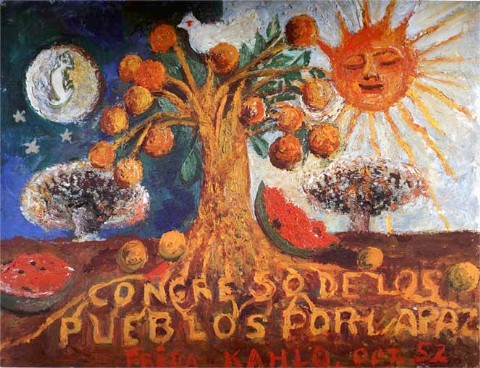Congress
of Peoples
for Peace
1952
Near the end of her life, Frida painted some works from bed and as a result of all the heavy pain killers and other medications, the quality of her art suffered. Here, in this painting and others of the same period, we can see that it is lacking the precise brush strokes and detail that she once used to produce. In 1952, the people of Vienna celebrated the "Congress of the peoples for peace" and Mexican plastic artists, including Frida, created works in homage to the Congress. As with other paintings, Frida depicted a background of night and day, a perpetual battle between light and dark in the Aztec culture. In the middle of both sits the peace dove as a symbol of hope. The words seem to be a part of the roots of the tree, a characteristic she previously used in her painting "Naturaleza Viva" (Living Nature) of the same year.

Oil
and tempera on masonite
7½" x 10"
Whereabouts unknown
Óleo y témpera sobre fibra dura
19,1 x 25,1
cm.
Paradero desconocido
Congreso de los
pueblos
por la paz
1952
Hacia el final de su vida, Frida pintó algunos cuadros desde la cama, y como resultado de todos los fuertes analgésicos y otros medicamentos, la calidad de su arte sufrió. Aquí, en esta pintura y otras del mismo periodo, podemos ver que no usa las precisas pinceladas y detalle que ella usó en el pasado. En 1952, Viena celebró el "Congreso de los pueblos por la paz" y artistas plásticos mexicanos, incluyendo Frida, crearon trabajos en homenaje al Congreso. Igual que con otras pinturas, Frida usó un fondo de noche y día, una batalla perpetua entre la luz y la oscuridad en la cultura azteca. En el medio de ambas está la paloma de la paz como un símbolo de esperanza; las palabras parecen ser parte de las raíces del árbol, una característica que previamente uso en su pintura "Naturaleza Viva" del mismo año.